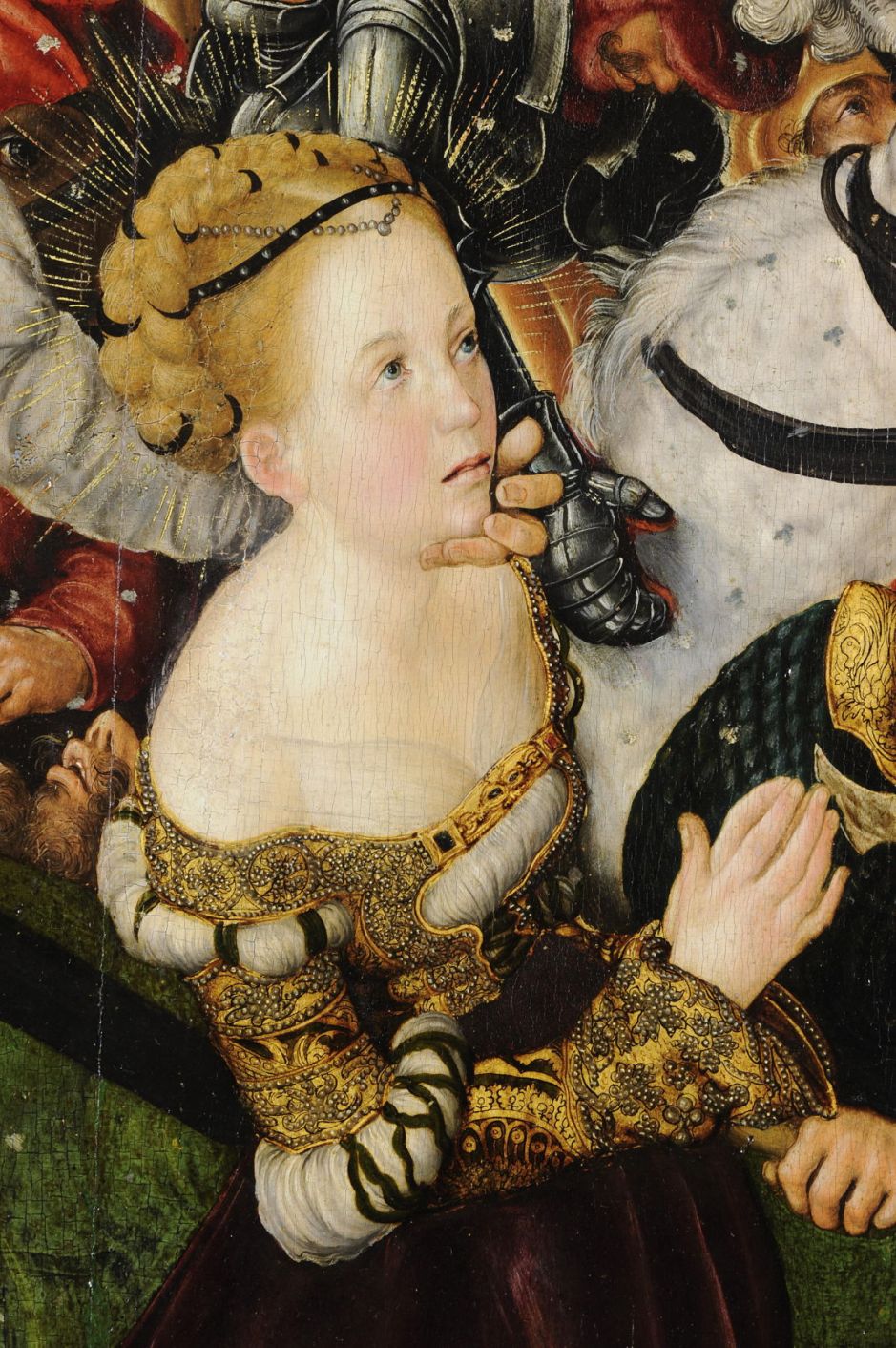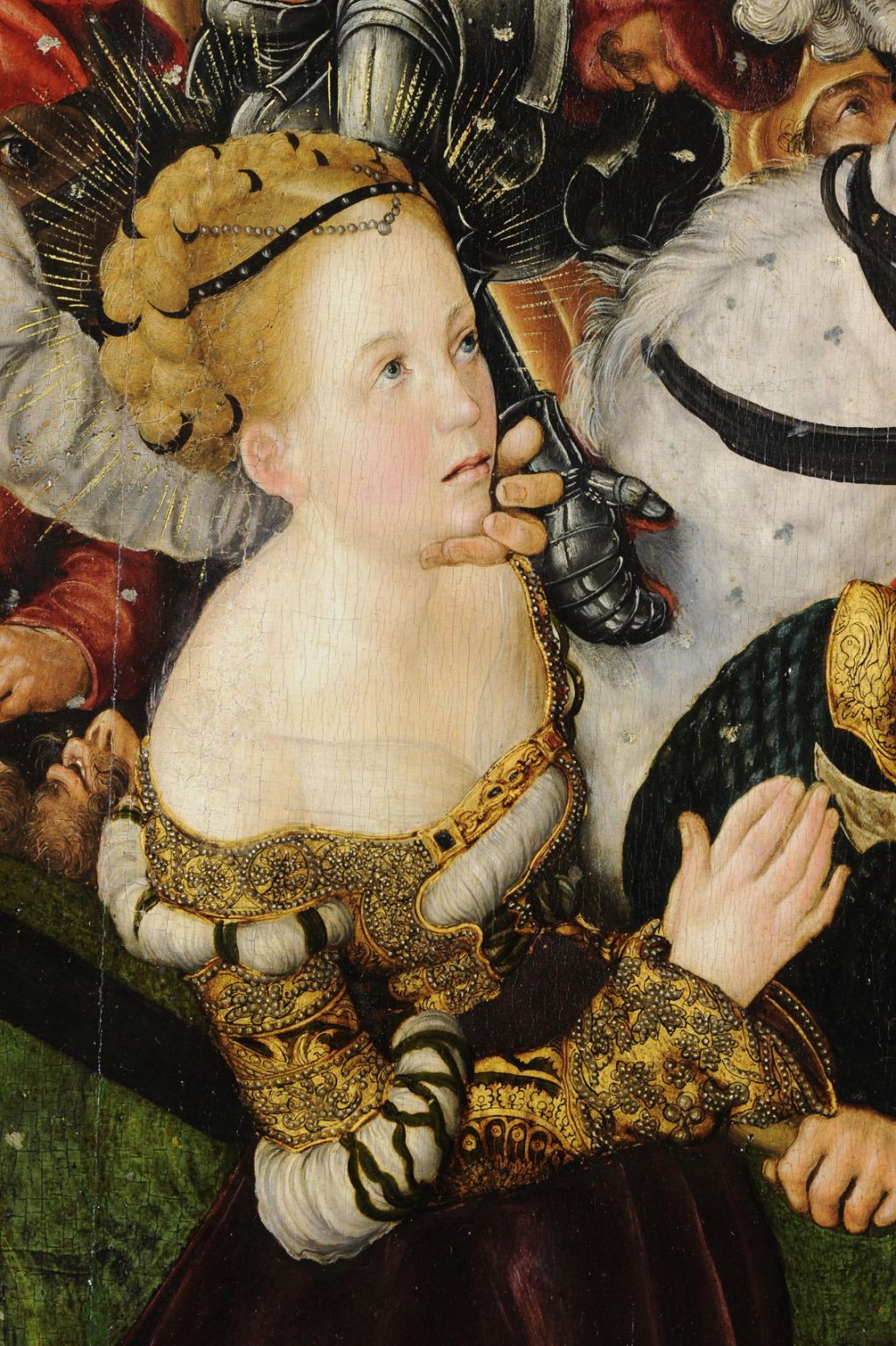Many superb paintings from both the northern and southern Renaissance were the product of months of planning and preparation, and the collaborative effort of the master and many other highly-skilled assistants and craftsmen. Wonderful though they are, they are usually painstakingly deliberate, rather than more spontaneous creative acts.
That wasn’t always the case. This week’s painting, by Lucas Cranach the Elder, shows evidence of greater spontaneity, as you might associate more with the nineteenth century: it’s his Martyrdom of Saint Catherine, painted when he was just over 30 years old.

Cranach either completed The Martyrdom of Saint Catherine in the year that he was appointed court painter to the Elector of Saxony, Friedrich III the Wise, or shortly after that appointment in Wittenberg, in eastern Germany.

Cranach would have developed a final study, much as this for his later David and Bathsheba (c 1526), using pen, black ink, and grey wash. Comparing his study above for its finished counterpart below, it’s obvious that many changes, some substantial, were made between the two.


Cranach and his workshop made several paintings of this particular motif. This small undated study was probably intended for a different version of The Martyrdom of Saint Catherine, although it has common features, such as the executioner with his large sword and vulgar bulging codpiece.
With the preparatory drawings advancing, the wood support had to be specified and fabricated by a specialist joiner. Later in his career, Cranach developed a system of standard sizes of panels, but he doesn’t appear to have followed that in this early phase. This painting’s wooden support was made from four broad boards of lime (linden) wood of unusual thickness, 1.6 cm (nearly 2/3rds of an inch). The boards are joined and stabilised using dovetail battens, and on the painting surface those joins were carefully covered with canvas strips.
The ground applied to the support consists of white pigment bound with animal glue, together with calcium carbonate prepared from local limestone as a filler, a traditional formula. Over this his assistants laid a thin layer of light reddish imprimatura coloured using a mixture of lead white and red lead pigments in an oil medium. This was applied using very wide bristle brushes.
Once that had dried thoroughly, Cranach himself laid down the underdrawing, using a pointed brush with carbon black ink made from soot. This extended to tonal modelling, and is shown clearly in the infra-red reflectogram below, and should have been very similar to his final drawn study, both in appearance and detail.

Where he needed precise geometric forms, such as in the cartwheel at the right, Cranach scratched the contours in the ground, in this case using dividers.
Cranach had a reputation for being an impulsive and rapid painter, which has been borne out by analysis of his works. His early paintings, in particular, show evidence of repeated adjustments in form and colour – which contrasts with Dürer’s much more determinate workflow, for instance. The reflectogram above shows how detailed are the figures in the foreground, but the pyrotechnic effects at the upper right were left to be extemporised during painting.
In infra-red reflectograms, invisible infra-red radiation illuminates the painting, and a camera sensitive to its wavelengths, here between 900-1700 nm, is used to record the image. This effectively looks through the paint layer at the underdrawing beneath.

Looking in more detail at the figure of the executioner and those around him, in visible light above and the reflectogram below, it’s clear that Cranach made considerable changes during the painting process.

With the underdrawing complete, areas to be gilded were then prepared for the application of gold leaf. Cranach and his workshop varied their techniques even within each painting: most of their gilding used unburnished mordant methods, but these were employed prior to painting, during the application of paint, and in at least one passage in The Martyrdom of Saint Catherine on top of the paint!

Paints were prepared in Cranach’s workshop, using pigments which were usually purchased from a pharmacy; in 1520, Cranach himself was granted permission to establish a pharmacy in Wittenberg, so he could purchase pigments and other specialist materials through the trade. His main binder was linseed oil, which was available plentifully across northern Europe. This was also used after heat treatment to thicken it, a technique which is almost as old as oil painting itself.
Initial painting in much of this work consisted of undermodelling using grey tones of carbon black and lead white. Some of the darker garments were preceded by a local underpainting of black, a technique which was popular at the time for dark red fabrics in particular. Much of this seems to have been completed very quickly, probably within a single day. Some passages were then continued rapidly, on occasion painted wet in wet.
More typically, passages were worked up through modelling in layers of paint, allowing time to dry between applications, with glazes being applied later in the sequence to complete the surface effects of different fabrics and textured materials. Cranach is unusual for repeatedly correcting and refining both forms and detail as the painting progressed, as shown in the changes he made between the underdrawing seen in the reflectogram and the finished painting.

Cranach’s paintings of the martyrdom of saints were much in demand, and the final step with most of these works was the preparation of woodcuts to make prints. I haven’t been able to locate a print made of this particular painting, but this undated woodcut of The Martyrdom of Saint Barbara is well known.

Unlike many more modern paintings, Cranach didn’t dash off The Martyrdom of Saint Catherine in a few hours, but it was the product of considerable extemporisation, even a touch of bravura in its pyrotechnics, which gives it a distinctive and dynamic realism.
References
cranach.net a massive research database with many visible light and other images. Requires registration. (German)
cda the Cranach Digital Archive, another huge research and image resource, in English or German.
Heydenreich G (2007) Lucas Cranach the Elder, Painting Materials, Techniques, and Workshop Practice, Amsterdam UP. ISBN 978 90 5356 745 6.

